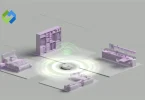Sticky headers are important in web design because they make navigation easier. Users can quickly access key links without scrolling back up. This improves the overall user experience and keeps visitors engaged with the site. Sticky headers are especially useful on content-heavy websites where quick access to different sections is needed.
Table of Contents
Table of Contents
How Sticky Headers Work
Sticky headers work by using a combination of CSS and sometimes JavaScript to keep a header fixed at the top of the screen as you scroll down a webpage. When a page first loads, the header appears at the top as usual. But as you start to scroll, the sticky header remains visible, “sticking” to the top of the browser window. This behavior is controlled by the CSS property position: sticky;. This property allows the header to switch from a normal, static position to a fixed position when the user scrolls past a certain point on the page.
In addition to the basic position: sticky; CSS property, other CSS properties like top, z-index, and background-color are often used to ensure the sticky header functions correctly and appears above other content. The top property defines where the sticky header should stick to the screen, usually set to 0 for the top of the viewport. The z-index property ensures that the sticky header appears above other elements on the page, preventing it from being hidden by other content. Lastly, a solid background-color can be added to the sticky header to ensure it stands out and is easily visible as users scroll.
JavaScript can be added to further enhance the functionality of sticky headers. For example, JavaScript can be used to change the appearance of the sticky header based on the user’s scroll position, such as shrinking the header size or changing its color to provide visual feedback to users. It can also add smooth scrolling effects or animations when the header becomes sticky. These enhancements can make the sticky header more dynamic and user-friendly.
Benefits of Using a Sticky Header
Using a sticky header offers several benefits that enhance both user experience and website performance.
- Improved Navigation: A sticky header keeps essential navigation links, like the menu or search bar, always visible at the top of the page. This means users don’t have to scroll back up to access these links, making it easier to explore different parts of the website. This is especially useful for long pages or content-heavy sites, where quick access to various sections is important.
- Enhanced User Experience: By keeping the header in place, users can always see important information, such as the website logo, contact details, or a shopping cart icon. This constant visibility helps users feel more in control and reduces frustration, as they can easily find what they need without excessive scrolling. A sticky header also adds a sense of consistency, making the site feel more user-friendly and intuitive.
- Increased Time on Page: Because sticky headers make navigation easier, users are more likely to stay on the site longer. They can easily move between different sections or pages without losing their place, which encourages them to explore more content. This can lead to increased engagement, reduced bounce rates, and potentially higher conversion rates for businesses.
- Mobile-Friendly Design: On mobile devices, where screen space is limited, sticky headers ensure that key navigation elements remain accessible without taking up too much space. When designed correctly, a sticky header can improve the mobile browsing experience by keeping important links within reach while allowing the user to focus on the content.
Potential Drawbacks
While sticky headers offer many benefits, they also come with potential drawbacks that designers should consider.
- Usability Concerns: A sticky header, if not properly designed, can take up valuable screen space, especially on smaller devices like smartphones. This can reduce the amount of visible content on the screen, forcing users to scroll more than necessary. If the header is too large or cluttered, it can become a distraction and make the site feel cramped.
- Impact on Mobile Experience: On mobile devices, screen real estate is limited, and a poorly implemented sticky header can negatively affect the user experience. If the header is too tall or doesn’t adjust well to smaller screens, it can dominate the screen and make it difficult for users to interact with the content below. This can lead to frustration and potentially drive users away from the site.
- Performance Considerations: Sticky headers, especially those enhanced with JavaScript or animations, can add extra load to a webpage. This can slow down the page loading time, particularly on devices with slower internet connections or lower processing power. If the sticky header is not optimized, it can negatively impact the overall performance of the site, leading to a less smooth browsing experience.
- Design Limitations: A sticky header can also limit design flexibility. Since it remains visible as users scroll, it must be carefully designed to work well with all parts of the site. This can sometimes restrict creative design choices or require additional effort to ensure the sticky header complements the rest of the page content without clashing or looking out of place.
Best Practices for Implementing Sticky Headers
1. Keep It Simple and Compact
Ensure the sticky header is as compact as possible to avoid taking up too much screen space. Focus on including only the most essential elements, such as the logo, primary navigation links, and a search bar. Avoid cluttering the header with unnecessary content, as this can overwhelm users and make the site feel cramped.
2. Optimize for Mobile Devices
Design the sticky header to be responsive, adapting to different screen sizes, especially on mobile devices. Use CSS media queries to adjust the header’s height, font size, and layout for smaller screens. Consider implementing a collapsible menu (hamburger menu) to save space on mobile devices while still providing easy access to navigation options.
3. Ensure Smooth Scrolling and Performance
Optimize the sticky header to avoid performance issues that can slow down page loading. Minimize the use of heavy JavaScript and animations that could negatively impact performance, particularly on devices with limited processing power. Additionally, test the sticky header across various browsers and devices to ensure it works smoothly for all users.
4. Prioritize Accessibility
Make sure the sticky header is accessible to all users, including those with disabilities. Use semantic HTML for the header structure, and ensure that navigation links are keyboard-friendly. Provide sufficient contrast between the header’s text and background colors, and ensure the header remains readable as users scroll. Adding aria labels can also improve the accessibility of navigation elements.
5. Test for Usability
Before deploying a sticky header on a live site, conduct usability testing to see how it performs in real-world scenarios. Gather feedback from users on how easy it is to navigate the site with the sticky header in place. Pay attention to any issues with usability or performance, and be prepared to make adjustments based on user feedback.
FAQs
Q. Can I customize the appearance of a sticky header?
Yes, you can customize the colors, fonts, and layout of a sticky header to match your website’s design.
Q. Do sticky headers work on all web browsers?
Most modern web browsers support sticky headers, but it’s important to test them across different browsers to ensure compatibility.
Q. Will a sticky header slow down my website?
If not optimized, a sticky header can slow down your site, especially if it includes heavy scripts or images. Optimization is key.
Q. Can I make only part of the header sticky?
Yes, you can make specific sections of the header sticky, like the navigation menu, while allowing other parts to scroll normally.
Q. Is it possible to hide a sticky header on certain pages?
Yes, you can use CSS or JavaScript to disable the sticky header on specific pages where it may not be needed.
Conclusion
A sticky header is a valuable tool in web design that helps keep important navigation elements always visible as users scroll down a page. By using a sticky header, you can make it easier for visitors to access key links, improving their overall experience on your website. It can be especially useful for content-heavy sites, where quick and easy navigation is essential.
However, it’s important to implement sticky headers thoughtfully. They should be designed to enhance the user experience without taking up too much screen space or slowing down your site. By following best practices and optimizing for both desktop and mobile users, you can create a sticky header that adds value without causing distractions.














